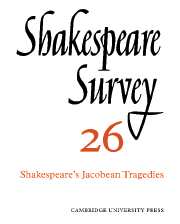Book contents
- Frontmatter
- Studies in Shakespearian and Other Jacobean Tragedy, 1918–1972: A Retrospect
- ‘Form and Cause Conjoin’d’: ‘Hamlet’ and Shakespeare’s Workshop
- The Art of Cruelty: Hamlet and Vindice
- From Tragedy to Tragi-Comedy: ‘King Lear’ as Prologue
- Jacobean Tragedy and the Mannerist Style
- ‘King Lear’ and Doomsday
- Macbeth on Horseback
- Shakespeare’s Misanthrope
- ‘Antony and Cleopatra’ and ‘Coriolanus’, Shakespeare’s Heroic Tragedies: A Jacobean Adjustment
- Shakespeare’s Venus and Adonis Sonnets
- Orlando: Athlete of Virtue
- The Unfolding of ‘Measure for Measure’
- Shakespeare and the Eye
- No Rome of Safety: The Royal Shakespeare Season 1972 Reviewed
- The Year's Contributions to Shakespearian Study 1 Critical Studies
- 2 Shakespeare’s Life, Times, and Stage
- 3 Textual Studies
- Index
- Plate section
Shakespeare and the Eye
Published online by Cambridge University Press: 28 March 2007
- Frontmatter
- Studies in Shakespearian and Other Jacobean Tragedy, 1918–1972: A Retrospect
- ‘Form and Cause Conjoin’d’: ‘Hamlet’ and Shakespeare’s Workshop
- The Art of Cruelty: Hamlet and Vindice
- From Tragedy to Tragi-Comedy: ‘King Lear’ as Prologue
- Jacobean Tragedy and the Mannerist Style
- ‘King Lear’ and Doomsday
- Macbeth on Horseback
- Shakespeare’s Misanthrope
- ‘Antony and Cleopatra’ and ‘Coriolanus’, Shakespeare’s Heroic Tragedies: A Jacobean Adjustment
- Shakespeare’s Venus and Adonis Sonnets
- Orlando: Athlete of Virtue
- The Unfolding of ‘Measure for Measure’
- Shakespeare and the Eye
- No Rome of Safety: The Royal Shakespeare Season 1972 Reviewed
- The Year's Contributions to Shakespearian Study 1 Critical Studies
- 2 Shakespeare’s Life, Times, and Stage
- 3 Textual Studies
- Index
- Plate section
Summary
Interpretations
Shakespeare’s frequent interpretations of the expressions in the eyes of his characters may be said to provide a valuable type of evidence about their dispositions and conduct. We can, moreover, often notice that the dramatic quality of a play is enhanced as a result of the availability of such information. One or two descriptions of incidents in which analysis is a feature are quoted here, at the outset, as furnishing a useful prelude to what follows.
Philip the Bastard finds need at a critical juncture to try and infuse a sense of self-confidence in King John; but has little hope of being persuasive. He tries to bolster up the King's courage when he is faint-hearted, being faced with a menacing situation. The Bastard exhorts him to change his timorous appearance to that of stoutness of heart: 'Let not the world see fear and sad distrust / Govern the motion of a kingly eye!' (v, i, 46-7). Some years later the weak-spirited and shifty Duke of York argues in favour of the competence of Richard II to act as monarch. Though using assured language, he proves unconvincing when he addresses his companions, urging them to support the King against Bolingbroke's implicit threats to usurp the throne: 'Yet looks he [Richard II] like a king. Behold his eye, / As bright as is the eagle's, lightens forth / Controlling majesty' (iii, iii, 68-70).
- Type
- Chapter
- Information
- Shakespeare Survey , pp. 129 - 138Publisher: Cambridge University PressPrint publication year: 1973

